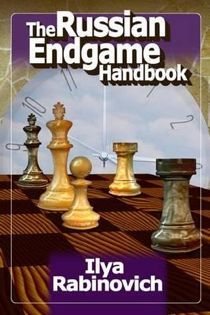Russian Endgame Handbook, The
Ilya Rabinovich

If youre looking for a reasonably complete (but not uber-encyclopedic) guide to important endgames, this book may be for you. This is not a new book it is a translation and reprinting of the authors 1938 second edition, Russian Endgame Handbook. While there are some areas where computer-aided analysis has changed the nature of endings (particularly those like queen and pawn endings where a large number of options must be considered) probably the vast majority of endgame theory hasnt changed all that much in the intervening 75 years, which makes this a still useful guide.
For those unfamiliar with the author, he was a strong master a five-time city champion of Leningrad/St. Petersburg and tied for first place in the 1934/35 USSR Championship (with another famous endgame author, Grigory Levinfish and ahead of, among others, Chekhover, Lisitsin, Ragozin and Yudovich). In the books forward, the author expresses his gratitude to M.M Botvinnik, N.D. Grigoriev, G .Y. Levinfish, M.M Yudovich, A.A. Troitzky and V.A. Chekhover all noted endgame virtuosos.
The Soviet school of chess is often (rightly) credited for bringing greater rigor and structure to chess study, and this certainly applies to the endgame. As examples, Botvinnik was regarded as a very fine endgame player, Smyslov and Levinfishs book on rook endgames is considered a classic, and this book is generally held in similarly high esteem.
The author indicates that the book was conceived as a method for advising instructors and teachers engaged in group learning settings. By this, the author meant that an instructor must assist students of all different levels of skill and understanding. As a result, the book covers endings from the most basic (yes, even queen and king versus king), to very complex multi-piece endings. In this respect, the book is more accessible than some other endgame books by noted Russian authors (I confess to never having been able to get my arms around Dvoretskys Endgame Manual).
Rabinovichs book works through its various topics by providing over 400 examples. There is a nice combination of analysis and discussion. Where some endgame books (Reuben Fines Basic Chess Endings comes to mind) mostly provide rules and then (often lengthy) examples to prove the rule (and Fines book, while a classic, has a lot of errors), this book provides many lengthy explanations that are almost entirely prose rather than chess variations. I found it struck a nice balance in this respect.
Each chapter also includes exercises/puzzles interspersed throughout, which allows the reader to test their knowledge and understanding of the chapters contents. In all, there 312 exercises included.
The book was translated by Jim Marfia, and, in my experience, he does a fine job. The text flows naturally and lacks the stilted nature of some translations. According to the editors preface (edited by Jorge Amador), they made slight alterations to the voice, to make the final result sound more natural to the minds ear in our less formal times, yet without changing the meaning of any statement. From my reading, they did a nice job. The editors preface also notes that they dispensed with the more complex aspects of the authors discussion of the theory of corresponding squares, which we consider to be of diminishing value in these times of increasingly fast time controls and sudden-death play. I suspect that this was a reasonable accommodation as I noted earlier, some of these sorts of discussions can bog all but the most advanced reader down in a thicket of variations and explanation that doesnt necessarily advance their basic knowledge and understanding of the endgame.
In conclusion, this is an older endgame book that, like a fine wine, has aged pretty well. There is a lot of content packed in its 500 plus pages, and it should prove useful for tournament players at nearly every level, from relative newcomer to national master.
